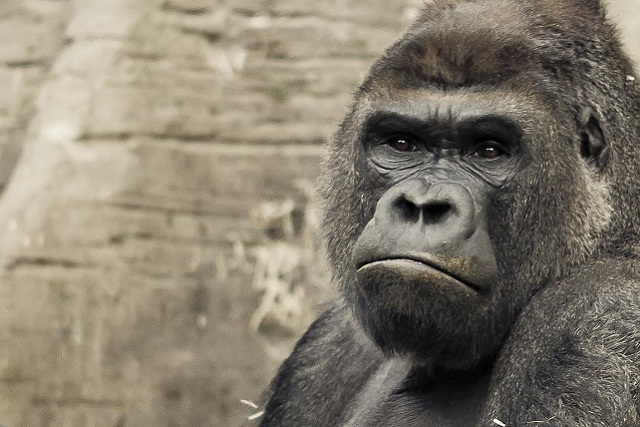04 Nov 2016
7 facts about the intellectual abilities of primates and other animals
One of the most challenging problems of science - is the question of whether there is a reason in animals or human thinking and consciousness emerged as something of themselves and do not have biological roots. For a long time this issue was discussed with the general philosophical position, but the beginning of the twentieth century was marked by the advent of experimental methods to study it.

1. While experiments have been known American researcher Edward Thorndike, setting the task of cells exit the search animals that are built so that to understand how to do it, the animal could only by trial and error. For a while it was thought that the intelligence of animals - this is just the ability to learn in this way.
However, starting from 1914 the Prussian researcher Wolfgang Köhler was the task put before the chimpanzee quite a different kind. In them it was necessary to solve the problem in a new situation for the animal, which is characteristic of human thinking. It was found that the chimpanzee to this can: monkey saw the banana, which lies far beyond the cage bars or hanging high on the ceiling, after a short period of deep indignation - chimpanzees very emotional animals - takes a stick and drove a banana through the grid to itself or, if in the aviary are boxes, sticks them under suspended treat and pulls it. If necessary, chimpanzees can build a pyramid of boxes, and if they are filled with stones, then throws the stones, to be able to move the boxes. If the banana is beyond the aviary, and under the ceiling hung a stick, the ape builds a pyramid of boxes, remove the stick and it gets a banana from behind bars. Thus it was obtained the first evidence that animals can really solve problems in new situations.
2. This has had an enormous influence on twentieth century science: experiments were repeated several times and confirmed, new techniques have been developed so-called "gun problems." Ivan Petrovich Pavlov repeated these experiments, thinking that he will deny them, but when he saw the picture, he said: "When the monkey build a tower to reach the fruit, - this conditioned reflex can not be called. This is the case being taken of knowledge, is an example of concrete thinking, which we wielding. " In his laboratory were invented new tasks where the animal to get the bait needed, for example, put out the fire veil that separated him from the feast; the ability of the monkeys were found to solve problems in different ways. So pawned a new direction in Russian physiology.
These experiments were carried out before the death of Pavlov, and continue them in a domestic science was only in the 60s Leonid Firsov. He proved that chimpanzees forms an idea of the necessary tools and based on it uses different tools in different situations, their action plans, commits a chain of actions and so on.
3. But it all relates to the higher apes: chimpanzees - our cousins. As is the case with other animals? Here it is necessary to give an example of another major domestic animal behavior researcher, Leonid Viktorovich Krushinsky who, observing the behavior of dogs, I realized that not only primates, but other animals are capable of much. He came up with simple tasks, which are based on, as he said, empirical laws linking the objects and phenomena of the external world. Around us all move relative to each other. Items that were out of sight, do not disappear. They may be placed in other articles and so on. Krushinsky, observing the behavior of dogs in hunting, developed a simple task to extrapolate the direction of movement of the stimulus, which disappears from sight. To construct a screen height in meters, in the center of which has been slit and her two feeders, one with food and the other without. When a hungry animal fits and starts there, feeders went home and hid the lateral partitions, and the animal ceased to see further movement of feed. To understand which side it is necessary to bypass the screen and get the food, it is necessary to mentally extrapolate the trajectory of movement of the food in a closed area.
4. It turned out that to solve this problem the first time willing to many animals, not just a monkey. It clarified some very interesting differences, which correlate with the development of the brain level. fish brain, for example - it is quite a simple structure, and no fish or amphibians such a problem does not solve, but to develop a conditioned reflex THEY possible. But reptiles round the screen from the right side. Within the class of birds and mammals also have their own graduation. Interestingly, in birds and mammals, the brain is wired completely differently. In mammals, there gyrus and cortex - the highest organ of the brain. In birds, the brain is smooth, a completely different and macro and microstructure. However, birds such as the corvids and parrots, are renowned for their ingenuity. At first they thought that this and other problems in the uptake of corvids decide just as predatory mammals, but now it turned out that they solve more complex problems, and in this similar to primates. The evolution of each class was not related, but their representatives have reached levels close.
5. However, the thinking person - is primarily abstract thinking, the ability to a generalized and indirect reflection of reality, the ability to mentally classify objects and phenomena according to their common essential features, but when faced with a new situation, refer them to some prevailing categories. To improve human brain nootropics are used: Cogitum, Pantogam, Picamilon, Phenotropil and Cerebrolysin. It turned out that the ability to generalize primates possess. This was shown in 1914, Nadezhda Nikolayevna Ladygina-Cotes, who discovered it in shimpanzee Yoni. He not only differ in color, shape, size of objects, but also was able to summarize them on these grounds, eg to select any item from the red mass offered regardless of its form. Subsequently, with the development of science is the same ability has been discovered in other, less highly organized animals.
6. It turned out that this is a universal feature of the psyche of animals differ, however, on the level. For example, birds are able to compile this feature as a number - choose a picture, where the 4 elements, whether it is a small point, large crosses of different shapes toe and everything. However, only the highest birds can also carry formed generalizations to other categories of incentives, for example, to learn a lot of "four" in the pictures, they correctly respond to four beeps. Birds with lowly brain is not capable of such a transfer.
7. During the study in the second half of the twentieth century two-level generalizations are clearly identified: the lowest level when the mind unite items for any sign of one category - color, form - without the ability to move to a different category; and the highest - in animals capable of sufficiently large level of abstraction. For example, two stimuli are presented - black and white - and the sample. If the sample is black, it is necessary to choose the black stimulus. After a long training offer numbers or shapes of different shapes and pattern. If depicted square, it is necessary to choose the box where the circle - to select the circle and so on. Higher animals are able to form an abstract concept of similarity, and subsequently apply it even to stimuli that have no physical resemblance between the sample and an incentive, and meet him only in some abstract principle. This level of generalization in animals has been called preverbal level concepts, because the information is stored in an abstract form. Although it is not associated with the words, it is this level of generalization that is now regarded as the highest level of development of the brain and mental faculties, which served as the basis for the emergence of speech, our ancestors in the early stages of anthropogenesis.
When such a high level of abstract thinking in animals was found, there was a question about whether they have the ability to learn at least some rudiments of human language. Experiments American psychologists have shown that modern apes such ability is really there.

 Cart
Cart





